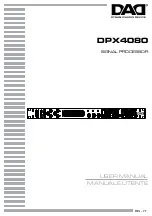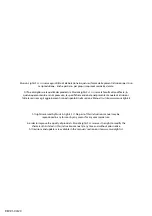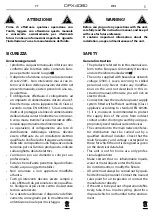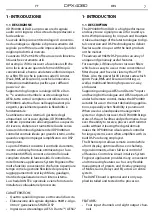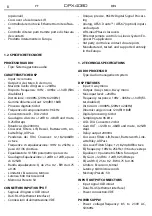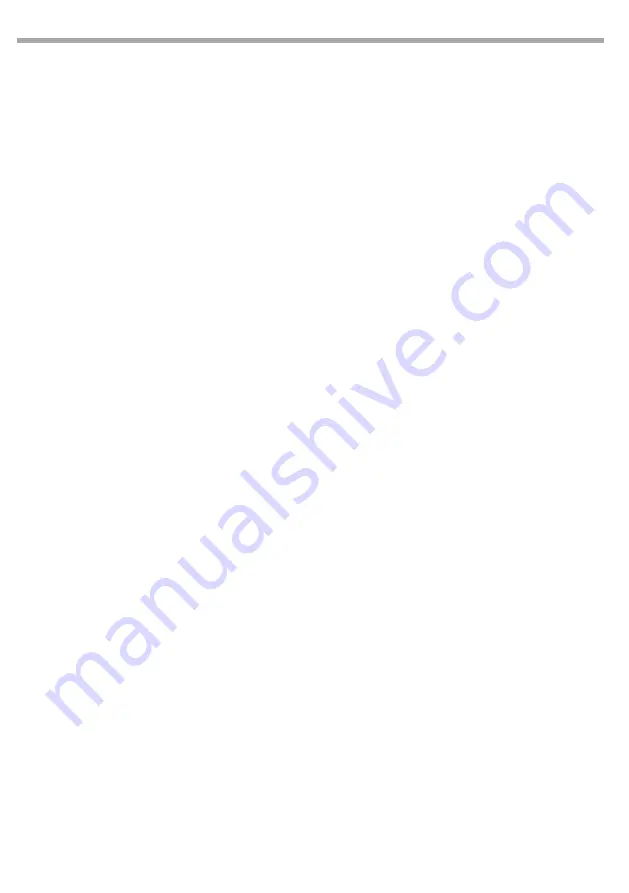
14
DPX4080
EN
IT
eters for all the layers for a given section (Gain De-
lay, EQ etc.). When an Overlay parameter is active,
the Overlay indicator will become illuminated.
The combined Gain or Delay etc. associated with
a given section is shown on the module panel in
System Engineer, within square brackets [ ] under
the Delay and Gain for each input channel. The
combined EQ curve is shown in an olive colour.
The Input Mute button in System Engineer will
flash if an overlay mute is active. On the device,
the presence of an active overlay is generally indi-
cated by square brackets “[]” after the parameter
value on the display. An input overlay mute is in-
dicated on the mute/clip indicator for that chan-
nel flashing. Note that overlay parameters cannot
be adjusted on the device itself; these can only be
controlled by the System Engineer application.
However, overlay parameters may be removed on
the device – see Overlay Flush. Note that overlays
are not stored in presets or snapshots or carried
in settings files.
LIR Linear Phase Crossover Filtering
The DPX4080 also includes a new type of cross-
over filtering “Linear Impulse Response” (LIR)
crossover filtering, which results in a Linear Phase
crossover that has a constant delay regardless of
frequency (unlike other types of crossover which
delay different frequencies to a different extent,
thus smearing the arrival time). The LIR crossover
can thus be described as having a flat Group De-
lay response, and thus entirely free of Group De-
lay Distortion.
The shape of the LIR crossover filter is quite simi-
lar to a 4th order or 24dB/Oct Linkwitz-Riley filter,
and maintains zero phase difference between the
adjacent bands across the crossover region to
keep the polar response rock steady.
FIR Linear Phase Equalisation
The Input High-Shelf Equalisers use Finite Im-
pulse Response (FIR) filtering to produce Linear
Phase equalisation; that is all frequencies are de-
layed by the same amount, perfectly preserving
the transient response. This can also be important
in applications where different amounts of EQ
are applied to different parts of a speaker cluster,
such as to add ‘Throw’ EQ boost so that parts of
cluster which are throwing further can have HF
absorption correction added. If this EQ is not lin-
in tutti i moduli di quel gruppo, mantenendo co-
munque valori di parametri indipendenti in ciascun
gruppo. Ciò si ottiene nel dispositivo combinando
i parametri per tutti i layer per una data sezione
(ritardo di guadagno, EQ ecc.). Quando è attivo un
parametro Overlay, l’indicatore Overlay si illumina. Il
guadagno o il ritardo combinati ecc. Associati a una
determinata sezione sono mostrati sul pannello del
modulo in System Engineer, tra parentesi quadre []
sotto il ritardo e il guadagno per ciascun canale di
ingresso. La curva EQ combinata è mostrata in un
colore verde oliva. Il pulsante Input Mute nel System
Engineer lampeggerà se è attivo un silenziamento
overlay. Sul dispositivo, la presenza di un overlay
attivo è generalmente indicata da parentesi quadre
“[]” dopo il valore del parametro sul display. Un silen-
ziamento di sovrapposizione dell’ingresso è indicato
sull’indicatore di silenziamento / clip per quel canale
che lampeggia. Si noti che i parametri di overlay non
possono essere regolati sul dispositivo stesso; questi
possono essere controllati solo dall’applicazione
System Engineer. Tuttavia, i parametri di overlay pos-
sono essere rimossi sul dispositivo. Vedere Overlay
Flush. Si noti che gli overlay non sono memorizzati
in preset o istantanee o trasportati nei file delle im-
postazioni.
LIR Linear Phase Crossover Filtering
DPX4080 include anche un nuovo tipo di filtro cross-
over “Linear Impulse Response” (LIR) che produce un
crossover a fase lineare che ha un ritardo costante
indipendentemente dalla frequenza (a differenza di
altri tipi di crossover che ritardano frequenze diverse
in misura diversa , imbrattando così l’orario di arrivo).
Il crossover LIR può quindi essere descritto come
avente una risposta di ritardo di gruppo piatta, e
quindi completamente privo di distorsione di ritardo
di gruppo.
La forma del filtro crossover LIR è abbastanza simile
a un filtro Linkwitz-Riley del 4 ° ordine o 24dB / ott
e mantiene una differenza di fase zero tra le bande
adiacenti nella regione del crossover per mantenere
stabile la risposta polare.
FIR Linear Phase Equalisation
Gli equalizzatori di ingresso High-Shelfd utilizzano il
filtro FIR (Impulse Response) per produrre l’equaliz-
zazione a fase lineare; cioè tutte le frequenze sono
ritardate della stessa quantità, preservando perfetta-
mente la risposta transitoria.
Содержание DPX4080
Страница 40: ...40 DPX4080 EN IT Processing Block Diagram...
Страница 43: ...43 EN IT DPX4080 EQ and Filter Response Graphs...
Страница 44: ...44 DPX4080 EN IT...
Страница 51: ......

